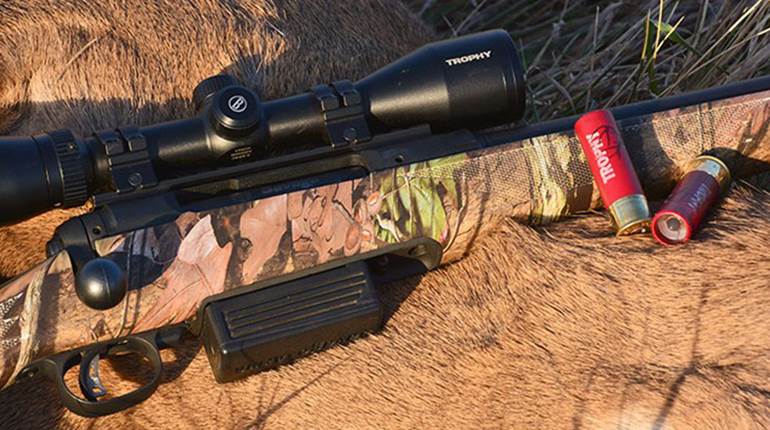
Blaser is well known as Germany’s premier riflemaker, a reputation based on its innovative designs and precision machining. With its F3 shotgun, Blaser has applied those strengths to an all-new, modular, competition over-under. Although it looks conventional and handles like many other target guns we’ve tested, inside it is a marvel of German engineering and machining tolerances.
The heart of the F3 is its CNC-machined steel receiver. It measures 2.415-inches high at its tallest point, making it one of the lowest-profile guns we’ve handled in some time. The finish is an even, utilitarian matte gray, and the only ornamentation is the “F3” model number on the receiver sides and “Blaser” engraved on the receiver’s bottom.
A 0.824-inch-wide Superposed-style underlug engages a recess in the bottom-rear of the monobloc. The monobloc’s 0.842-inch-wide, 0.746-inch-long underlump protrudes into a recess in the bottom of the receiver and is flush with its bottom when the action is closed. The lump’s front has a replaceable steel bolt or lock plate that can be removed by turning out two Allen screws, if wear over time makes this necessary.
The circular hinge pins on either side of the receiver’s interior, on which the barrels pivot, are also replaceable. The front face of the breech is unusual, as it is removable and replaceable. Viewed from the front, there are channels for the firing pins, but there are two Allen screws that allow the plate to be removed to change the firing pins or for replacement of the entire plate if their channels wear over time. Also, there are two other recesses for the ejector system’s activating pins.
A new Ejector Ball System is the subject of one of the nearly 10 patents taken out on the F3. Circular channels in the extractors mate up with the breech-mounted activating pins. When the firing pin for a given barrel travels forward, so does the activator pin. This depresses the rear of the ejector system, setting it; so, it is not the opening of the gun that cocks the ejector sears, rather, the activator pins cock them.
The trigger is a single, selective mechanical unit employing what Blaser calls the Inertia Block System to prevent doubling or fan firing. This system also blocks the forward movement of the hammers unless the trigger is pulled. The stainless steel trigger blade is adjustable for length and cant. Blaser also employs an in-line, hammer/firing-pin arrangement, positioned directly above the trigger group, for a claimed faster lock time. Barrel selection is via a button inside the trigger guard. In the rearmost position, the bottom barrel is selected. As befits a shotgun intended primarily for competition, the tang-mounted safety is not automatic. Pushing it rearward blocks the triggers, revealing an “S.”
Fore-end retention is via an updated Anson push rod. The wide, round fore-end body has scallops on either side of its top and three long panels of bordered, fine circular checkering on the sides and bottom. Our sample, designed for doubles trap, had a semi-beavertail fore-end combined with a pistol-grip-stocked butt with a generous palm swell, and it was slightly cast-off for right-handed shooters. Blaser also offers a host of other stock options for the F3.
Barrel lengths offered are 28, 30 and 32 inches, but, through proprietary metal technology, Blaser is able to make all three lengths weigh just about the same by changing the contours slightly—a definite advantage for competitive shooters, as the gun dynamics do not change markedly with a barrel change. The new barrel sets also require no fitting to change from one to another. The blued barrels have 3-inch chambers, are backbored to 0.736 inches and accept Briley interchangeable choke tubes.
We function-fired the F3 at sporting clays and pattern tested it with Federal Gold Medal No. 8s at 40 yards with the modified choke tubes in each barrel. Uniformity and pattern quality emulated the fit and finish of the gun. Not surprisingly, there were no failures of any kind, and we found the F3 to handle faster than one would suspect.
We found only one spot on the monobloc’s underside where faint machine marks remained. The finish inside the F3 was better than the outside of most of the guns we’ve evaluated. Its modular features, innovative engineering and excellent handling make this our most favored Blaser yet. While its more than $5,000 price makes it ill-suited to the financially faint of heart, those who can appreciate and afford the F3 will not be disappointed.
Manufacturer: Blaser Jagdwaffen GmbH, Ziegelstadel 1, D-88316, Isny im Allgäu, Germany
Importer: Sigarms Hunting Division (Dept. AR), 18 Industrial drive, Exeter, NH 03833; (603) 772-2302; www.sigsauer.com
Gauge: 12, 3" chamber
Action Type: break-open, over-under shotgun
Barrel: 28", 30" (tested) and 32"
Chokes: Interchangeable Briley tubes; full, improved-modified, improved cylinder, modified, skeet
Trigger Pull: single selective: 3 lbs., 4 ozs. (over); 3 lbs., 3 ozs. (under)
Stock: Turkish walnut: length of pull (adjustable), 14 5/8"; drop at comb, 15/16"; drop at heel, 1 7/8"
Overall Length: 50 1/8"
Weight: 8 lbs., 7 ozs.
Accessories: five choke tubes and wrench, hard case
Suggested Retail Price: $5,195 (standard)






































